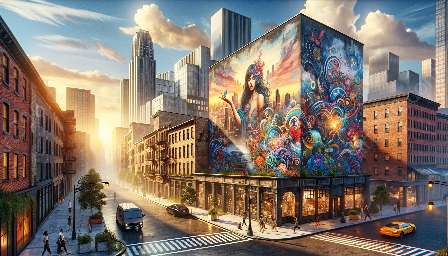Street art has long been intertwined with the social, cultural, and economic fabric of urban areas. It presents a complex relationship with gentrification and urban regeneration, offering a lens through which to understand the dynamics of urban transformation.
The Roots of Street Art
Street art, often associated with graffiti and murals, has historically been linked to marginalized communities expressing their voices and experiences in urban environments. It serves as a form of protest, a means of reclaiming public spaces, and a reflection of the social and political climate. As such, street art has been an integral part of the urban landscape, representing the diversity and creativity of city life.
Urban Regeneration and Street Art
Urban regeneration initiatives often utilize street art as a tool for revitalizing neglected or blighted areas. Murals, installations, and public art projects are leveraged to breathe new life into neighborhoods, attract visitors, and create a sense of place. Street art can transform barren walls into vibrant cultural landmarks, fostering community pride and engagement. This synergy between street art and urban regeneration illustrates the transformative power of creativity in reshaping urban spaces.
The Impact of Gentrification
However, the relationship between street art and gentrification is nuanced. As areas experience urban renewal and an influx of investment, the presence of street art can contribute to the aesthetic appeal and perceived cultural value of the neighborhood. This can attract a more affluent demographic, leading to rising property values, displacement of long-time residents, and changes in the socio-economic character of the area. In this context, street art can become commodified, losing its original grassroots and rebellious nature.
Community Voices and Diverse Perspectives
Community involvement and inclusivity are crucial in navigating the impacts of street art on gentrification. Engaging local artists, residents, and stakeholders in the decision-making process can ensure that street art projects align with the authentic identity and needs of the community. By amplifying diverse voices and perspectives, street art can be harnessed to tell the stories of the neighborhood, celebrate its heritage, and resist the homogenizing effects of gentrification.
Balancing Preservation and Progress
Integrating street art into urban regeneration efforts requires a delicate balance between preserving the authenticity and character of the neighborhood and fostering progress and development. This involves recognizing the value of street art as a form of cultural expression while addressing the potential consequences of its role in gentrification. Policies and strategies that prioritize community-driven approaches and equitable development can help mitigate the adverse effects of gentrification while harnessing the positive impact of street art in urban revitalization.
Conclusion
The relationship between street art, gentrification, and urban regeneration reflects the complexities of urban development. While street art has the potential to breathe life into urban spaces, it also intersects with the forces of gentrification, prompting a critical examination of its role in shaping the evolving urban landscape. By fostering dialogue, collaboration, and inclusive practices, street art can be harnessed as a catalyst for positive change, respecting the culture and diversity of urban communities while addressing the challenges of gentrification.

